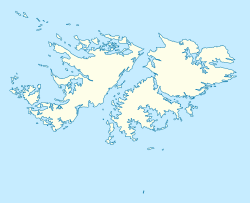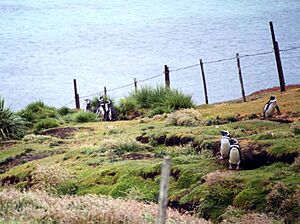Carcass Island facts for kids
Quick facts for kids
Carcass Island
Isla del Rosario
|
|
|---|---|
 |
|
| Country | Falkland Islands (UK) |
| Named for | English: "Carcass" after ship Spanish: Island of the Rosary |
| Main settlement | Port Patterson |
| Area | |
| • Total | 18.94 km2 (7.31 sq mi) |
| Highest elevation
(Mount Byng) |
220 m (720 ft) |
| Time zone | UTC−3 (FKST) |
| If shown, area and population ranks are for all islands and all inhabited islands in the Falklands respectively. | |
Carcass Island (also called Isla del Rosario in Spanish) is the biggest island in the West Point Island Group. It's part of the Falkland Islands.
About Carcass Island
Carcass Island is located northwest of West Falkland. It lies southeast of the Jason Islands. The island is about 10 kilometers (6 miles) long. Its widest part is about 2.5 kilometers (1.5 miles) across. The total area of the island is about 19 square kilometers (7.3 square miles).
The highest points on Carcass Island are Stanley Hill and Mount Byng. Both reach about 220 meters (720 feet) high. The northeast coast has tall cliffs and slopes. On the northwest side, you can find large sandy bays. There is also a rocky point that shows at low tide. Some areas of the island are covered in sand dunes. Leopard Beach is a common spot for boats to land.
Island History
The island's name, Carcass, comes from a ship called HMS Carcass. This ship explored the island in 1766. Another ship, HMS Jason, gave its name to the nearby Jason Islands. The captain of the Jason, John MacBride, also has a place named after him: MacBride Head.
For over 100 years, Carcass Island has been a sheep farm. It is currently owned by R. P. McGill. The island has three buildings that are protected for their history. These include a boathouse, a shed, and a store. The island's small village is on Port Patterson, on the southwest coast. This village is known for its beautiful gardens. It also has a small grocery shop.
During the Falklands War, Carcass Island was thought of as a possible landing spot for British forces. However, the British troops landed at San Carlos Water instead. This area is in the west of East Falkland. Carcass Island was not chosen for a few reasons. It was very close to Argentine bases on the mainland. It was also near an airbase on Pebble Island. Finally, it was far from Stanley, which was the main goal. So, West Falkland was not used in the war.
Plants and Animals
Even though Carcass Island has been a sheep farm for more than a century, its natural areas are well cared for. This has helped keep its many different habitats safe. Tall, thick tussac grass grows in coastal fields that have been replanted.
The island has one of the few large groups of trees in the Falklands. While there is a true forest at Hill Cove, the trees on Carcass Island are not found only here. They include interesting types like Monterey cypress trees. There are also New Zealand cabbage palms. Night herons build their nests in these trees. The gardens on the island also have plants brought from other places, such as fuchsias, lupins, and dog roses.
Carcass Island has no rats or cats. Because of this, it is home to many different kinds of birds. These include black-crowned night herons, which are called "quarks" in the Falkland Islands. You can also find seals and penguins here. The island has several large freshwater ponds. These ponds are important places for waterfowl (birds that live near water).
The West Point Island group, which includes Carcass Island, is recognized as an Important Bird Area (IBA) by BirdLife International. This means it's a very important place for bird conservation. Birds that are important to protect here include Falkland steamer ducks, ruddy-headed geese, gentoo penguins, southern rockhopper penguins, and Magellanic penguins. You can also see black-browed albatrosses, striated caracaras, blackish cinclodes, Cobb's wrens, and white-bridled finches.
Images for kids
See also
 In Spanish: Isla del Rosario para niños
In Spanish: Isla del Rosario para niños






